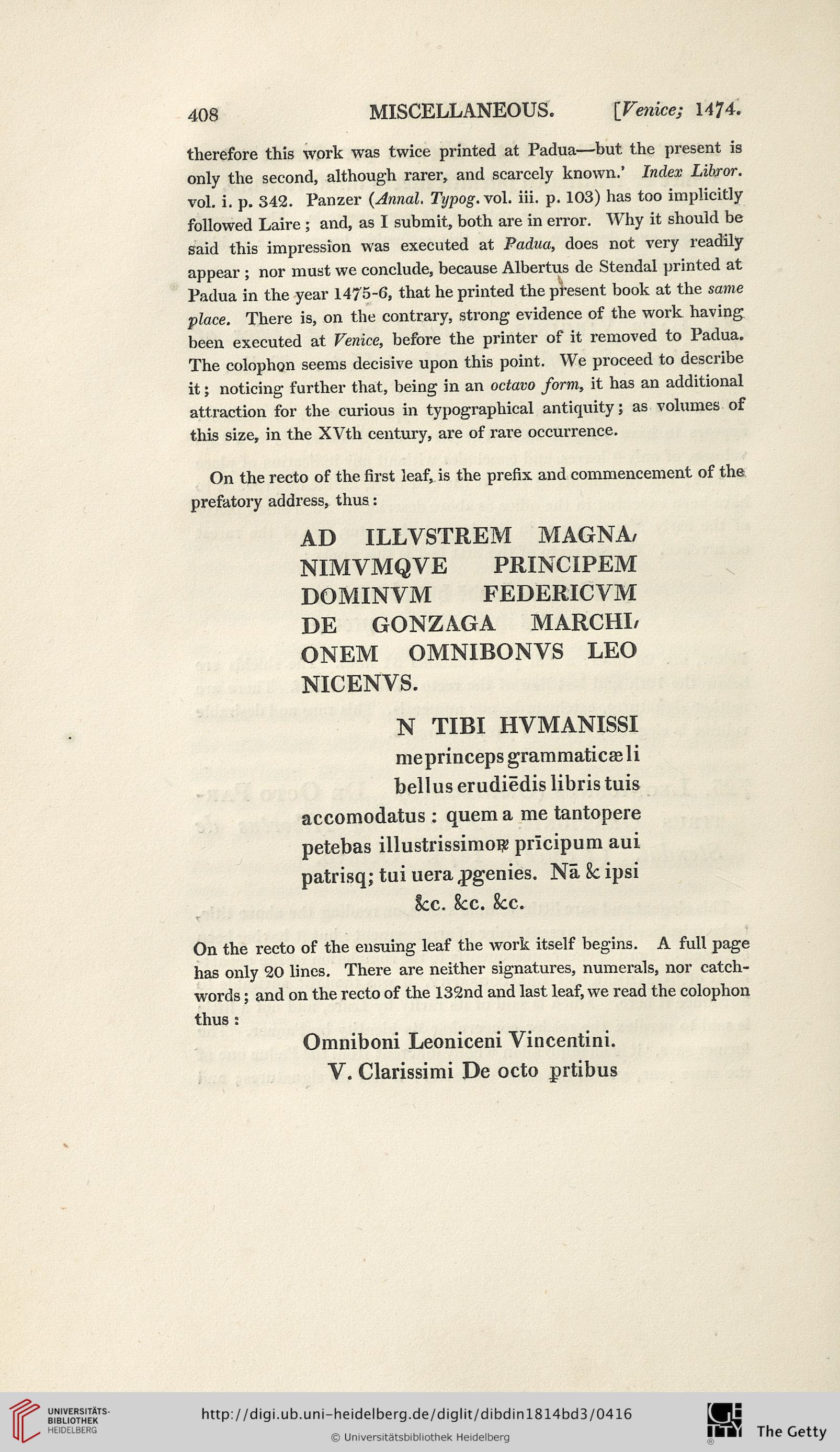408
MISCELLANEOUS.
sVenice; 1474.
therefore this work was twice printed at Padua—but the present is
only the second, althoug’h rarer, and scarcely known.’ Index Likror.
vol. i. p. 342. Panzer (Annal. Typog. vol. iii. p. 103) has too implicitly
followed Laire ; and, as I submit, both are in error. Why it should be
said this impression was executed at Padua, does not very readily
appear ; nor must we conclude, because Albertus de Stendal printed at
Padua in the year 1475-6, that he printed the present book at the same
place. There is, on the contrary, strong evidence of the work having
been executed at Venice, before the printer of it removed to Padua.
The colophon seems decisive upon this point. We proceed to describe
it; noticing- further that, being in an octavo sorm, it has an additional
attraction for the curious in typographical antiquity; as volumes of
this size, in the XVth century, are of rare occurrence.
On the recto of the first leaf, is the prefix and commencement of the
prefatory address, thus:
AD ILLVSTREM MAGNA/
NIMVMQVE PRINCIPEM
DOMINVM FEDERICVM
DE GONZAGA MARCHL
ONEM OMNIBONVS LEO
NICENVS.
N TIBI HVMANISSI
meprinceps grammaticae li
bellus erudiedis libris tuis
accomodatus : quem a me tantopere
petebas illustrissimo^ prlcipum aui
patrisq; tui uera .pgenies. Na 8c ipsi
Scc. 8cc. 8cc.
On the recto of the ensuing leaf the work itself begins. A full page
has only 20 lines. There are neither signatures, numerals, nor catch-
words; and on the recto of the 132nd and last leaf, we read the colophon
thus :
Omniboni Leoniceni Vincentini.
V. Clarissimi De octo prtibus
MISCELLANEOUS.
sVenice; 1474.
therefore this work was twice printed at Padua—but the present is
only the second, althoug’h rarer, and scarcely known.’ Index Likror.
vol. i. p. 342. Panzer (Annal. Typog. vol. iii. p. 103) has too implicitly
followed Laire ; and, as I submit, both are in error. Why it should be
said this impression was executed at Padua, does not very readily
appear ; nor must we conclude, because Albertus de Stendal printed at
Padua in the year 1475-6, that he printed the present book at the same
place. There is, on the contrary, strong evidence of the work having
been executed at Venice, before the printer of it removed to Padua.
The colophon seems decisive upon this point. We proceed to describe
it; noticing- further that, being in an octavo sorm, it has an additional
attraction for the curious in typographical antiquity; as volumes of
this size, in the XVth century, are of rare occurrence.
On the recto of the first leaf, is the prefix and commencement of the
prefatory address, thus:
AD ILLVSTREM MAGNA/
NIMVMQVE PRINCIPEM
DOMINVM FEDERICVM
DE GONZAGA MARCHL
ONEM OMNIBONVS LEO
NICENVS.
N TIBI HVMANISSI
meprinceps grammaticae li
bellus erudiedis libris tuis
accomodatus : quem a me tantopere
petebas illustrissimo^ prlcipum aui
patrisq; tui uera .pgenies. Na 8c ipsi
Scc. 8cc. 8cc.
On the recto of the ensuing leaf the work itself begins. A full page
has only 20 lines. There are neither signatures, numerals, nor catch-
words; and on the recto of the 132nd and last leaf, we read the colophon
thus :
Omniboni Leoniceni Vincentini.
V. Clarissimi De octo prtibus




